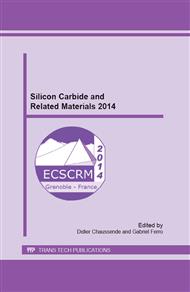p.90
p.96
p.100
p.104
p.108
p.115
p.121
p.125
p.129
Controlling Planar Defects in 3C-SiC: Ways to Wake it up as a Practical Semiconductor
Abstract:
Eelectrically active defects in 3C–SiC are investigated by considering the structures and interactions of planar defects. An anti-phase boundary (APB) largely degrades the blocking property of semiconductor devices due to its semimetallic nature. Although APBs can be eliminated by orienting the specific polar face of 3C-SiC along a particular direction, stacking faults (SFs) cannot be eliminated due to Shockley-type partial dislocation glide. SFs with Shockley-type partial dislocations form a trapezoidal plate which expands the Si-terminated surface with increasing 3C-SiC thickness. Although the density of SFs can be reduced by counter termination, specific cross-junctions between a pair of counter SFs forms a forest dislocation, and this is regarded as an electrically active defect. This paper proposes an effective way to suppress the forest dislocations and APBs which nucleate during 3C-SiC growth.
Info:
Periodical:
Pages:
108-114
Citation:
Online since:
June 2015
Authors:
Keywords:
Price:
Сopyright:
© 2015 Trans Tech Publications Ltd. All Rights Reserved
Share:
Citation:


